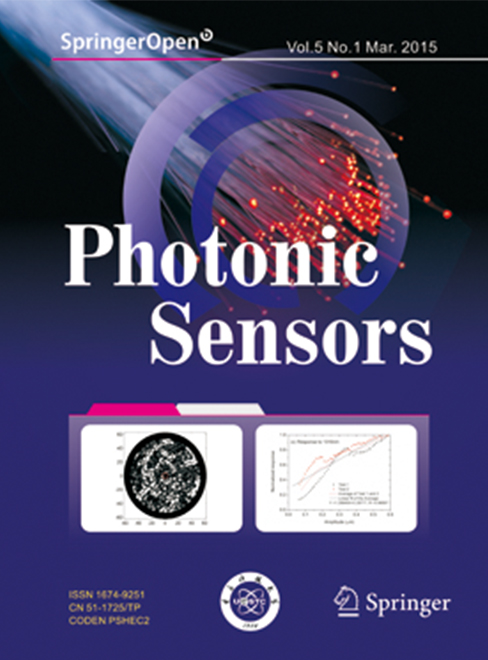 View fulltext
View fulltext
We demonstrate a novel optofluidic refractive index (RI) sensor with high sensitivity and wide dynamic range based on partial reflection. Benefited from the divergent incident light and the output fibers with different tilting angles, we have achieved highly sensitive RI sensing in a wide range from 1.33 to 1.37. To investigate the effectiveness of this sensor, we perform a measurement of RI with a resolution of ca. 5.0×10-5 refractive index unit (RIU) for ethylene glycol solutions. Also, we have measured a series of liquid solutions by using different output fibers, achieving a resolution of ca. 0.52 mg/mL for cane surge. The optofluidic RI sensor takes advantage of the high sensitivity, wide dynamic range, small footprint, and low sample consumption, as well as the efficient fluidic sample delivery, making it useful for applications in the food industry.
A reflective surface plasmon resonance (SPR) sensor based on optical fiber microring is proposed. In such a sensor, plasmons on the outer surface of the metallized channels containing analyte can be excited by a fundamental mode of a thin-core fiber (TCF). The refractive index (RI) sensing can be achieved as the surface plasmons are sensitive to changes in the refrective index of the analyte. Numerical simulation results show that the resonance spectrum shifts toward the shorter wavelength gradually when the analyte refractive index increases from 1.0 to 1.33, whereas it shifts toward the longer wavelength gradually when the analyte refractive index increases from 1.33 to 1.43, and there is a turning point at the refractive index value of 1.33. The highest sensitivity achieved is up to 2.30×103nm/RIU near the refractive index value of 1.0. Such a compact sensor has potential for gaseous substance monitoring.
Free space optical communication is a line-of-sight (LOS) technology that uses lasers to provide optical bandwidth connections. Potential disturbance arising from the weather condition is one of the most effective factors that influence the bi-directional free space optics (FSO) performance. The complex weather condition in the Middle East region and Arabian Gulf has been dominated by dust storms activities. Dust storms directly affect the characteristics of FSO and consequently lead to an increase in the bit error rate (BER) and deterioration Q-factor to bad levels due to the high attenuation factor. In this research, the authors compare the differences between two bi-directional FSOs. One is the traditional link, and the other has been developed to enhance the system performance under the dust storms condition. The proposed design consists of dual FSO channels, and each one includes erbium-doped fiber amplifier (EDFA) optical amplifiers. This design has demonstrated the proficiency in addressing the attenuation that occurs due to weather stickers. The results prove there is an improvement in performance by measuring the Q-factor. In addition, BER can be significantly improved, and further communicating distance can be achieved by utilizing 1550 nm with multiple channels and EDFA.
A micro structure porous cored octagonal photonic crystal fiber (P-OPCF) has been proposed to sense aqueous analysts (alcohol series) over a wavelength range of 0.80 μm to 2.0 μm. By implementing a full vectorial finite element method (FEM), the numerical simulation on the proposed O-PCF has been analyzed. Numerical investigation shows that high sensitivity can be gained by changing the structural parameters. The obtained result shows the sensitivities of 66.78%, 67.66%, 68.34%, 68.72%, and 69.09%, and the confinement losses of 2.42×10-10 dB/m, 3.28×10-11 dB/m, 1.21×10-6 dB/m, 4.79×10-10 dB/m, and 4.99×10-9 dB/m at the 1.33 μm wavelength for methanol, ethanol, propanol, butanol, and pentanol, respectively can satisfy the condition of much legibility to install an optical system. The effects of the varying core and cladding diameters, pitch distance, operating wavelength, and effective refractive index are also reported here. It reflects that a significant sensitivity and low confinement loss can be achieved by the proposed P-OPCF. The proposed P-OPCF also covers the wavelength band (O+E+S+C+L+U). The investigation also exhibits that the sensitivity increases when the wavelength increases like SO-band<SE-band <SS-band < SC-band <SL-band <SU-band. This research observation has much pellucidity which has remarkable impact on the field of optical fiber sensor.
The polymer waveguide optical biosensor based on the Mach-Zehnder interferometer (MZI) by using spectral splitting effect is investigated. The MZI based biosensor has two unequal width sensing arms. With the different mode dispersion responses of the two-arm waveguides to the cladding refractive index change, the spectral splitting effect of the output interference spectrum is obtained, inducing a very high sensitivity. The influence of the different mode dispersions between the two-arm waveguides on the spectral splitting characteristic is analyzed. By choosing different lengths of the two unequal width sensing arms, the initial dip wavelength of the interference spectrum and the spectral splitting range can be controlled flexibly. The polymer waveguide optical biosensor is designed, and its sensing property is analyzed. The results show that the sensitivity of the polymer waveguide optical biosensor by using spectral splitting effect is as high as 104 nm/RIU, with an improvement of 2–3 orders of magnitude compared with the slot waveguide based microring biosensor.
In view of the existing electrical vibration monitoring traditional hydraulic pump vibration sensor, the high false alarm rate is susceptible to electromagnetic interference and is not easy to achieve long-term reliable monitoring, based on the design of a beam of the uniform strength structure of the fiber Bragg grating (FBG) vibration sensor. In this paper, based on the analysis of the vibration theory of the equal strength beam, the principle of FBG vibration tuning based on the equal intensity beam is derived. According to the practical application of the project, the structural dimensions of the equal strength beam are determined, and the optimization design of the vibrator is carried out. The finite element analysis of the sensor is carried out by ANSYS, and the first order resonant frequency is 94.739 Hz. The vibration test of the sensor is carried out by using the vibration frequency of 35 Hz and the vibration source of 50 Hz. The time domain and frequency domain analysis results of test data show that the sensor has good dynamic response characteristics, which can realize the accurate monitoring of the vibration frequency and meet the special requirements of vibration monitoring of hydraulic pump under specific environment.
Optical metamaterials can concentrate light into extremely tiny volumes to enhance their interaction with quantum objects. In this paper, a cylindrical microcavity based on the Au-dielectric-Au sandwiched structure is proposed. Numerical study shows that the cylindrical microcavity has the strong ability of localizing light and confining 103- – 104-fold enhancement of the electromagnetic energy density, which contains the most energy of the incoming light. The enhancement factor of energy density G inside the cavity shows the regularities as the change in the thickness of the dielectric slab, dielectric constant, and the radius of gold disk. At the normal incidence of electromagnetic radiation, the obtained reflection spectra operate in the range from 4.8 μm to 6 μm and with the absorption efficiency C (C=1–Rmin), which can reach 99% by optimizing the structure’s geometry parameters, and the dielectric constant. Due to the symmetry of the cylindrical microcavities, this structure is insensitive to the polarization of the incident wave. The proposed optical metamaterials will have potential applications in the surface enhanced spectroscopy, new plasmonic detectors, bio-sensing, solar cells, etc.
We demonstrate a distributed optical fiber sensing system based on the Michelson interferometer of the phase sensitive optical time domain reflectometer (φ-OTDR) for acoustic measurement. Phase, amplitude, frequency response, and location information can be directly obtained at the same time by using the passive 3×3 coupler demodulation. We also set an experiment and successfully restore the acoustic information. Meanwhile, our system has preliminary realized acoustic-phase sensitivity around 150 dB (re rad/μPa) in the experiment.
In this research, the effects of target sputtering power on the structure and optical properties of radio frequency (RF) sputtered Ti6Al4V films were investigated. Different sputtering RF powers were used to produce different thicknesses of Ti6Al4V thin films. From the X-ray diffraction, it was found that the Ti6A14V films had polycrystalline cubic and hexagonal structures and increased films crystallinity and crystalline size with increasing the sputtering power. Atomic forces microscopy (AFM) gave us a nanometric film character, films homogeneity, and surfaces roughness. A higher degree of roughness and average grain size with increasing RF power was exhibited. Band gap and refractive index of Ti6Al4V thin films varied with sputtering RF powers.
A rigid conformal (RC) lap can smooth mid-spatial-frequency (MSF) errors, which are naturally smaller than the tool size, while still removing large-scale errors in a short time. However, the RC-lap smoothing efficiency performance is poorer than expected, and existing smoothing models cannot explicitly specify the methods to improve this efficiency. We presented an explicit time-dependent smoothing evaluation model that contained specific smoothing parameters directly derived from the parametric smoothing model and the Preston equation. Based on the time-dependent model, we proposed a strategy to improve the RC-lap smoothing efficiency, which incorporated the theoretical model, tool optimization, and efficiency limit determination. Two sets of smoothing experiments were performed to demonstrate the smoothing efficiency achieved using the time-dependent smoothing model. A high, theory-like tool influence function and a limiting tool speed of 300 RPM were obtained.
Plasmonic metal-insulator-metal (MIM) waveguides sustain excellent property of confining the surface plasmons up to a deep subwavelength scale. In this paper, linear and S-shaped MIM waveguides are cascaded together to design the model of Mach-Zehnder interferometer (MZI). Nonlinear material has been used for switching of light across its output ports. The structures of even and odd parity generators are projected by cascading the MZIs. Parity generator and checker circuit are used for error correction and detection in an optical communication system. Study and analysis of proposed designs are carried out by using the MATLAB simulation and finite-differencetime- domain (FDTD) method.








